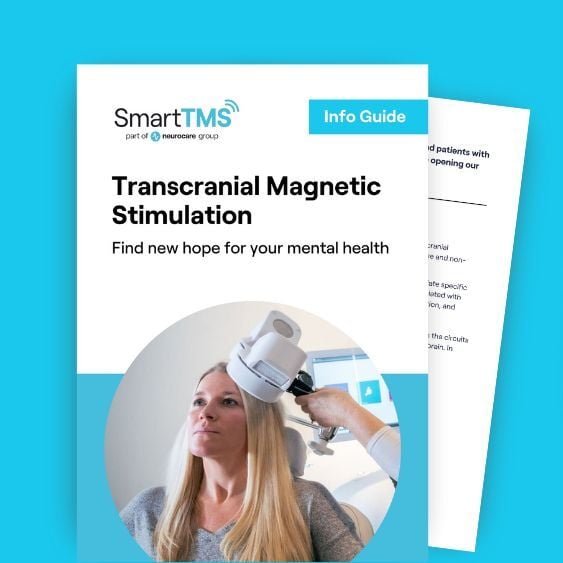Understanding Neurodivergence: TMS Therapy for ADHD, OCD, and More
July 10, 2025 - Smart TMS

Wired Differently: Exploring Biological, Structural and Functional Differences in Neurodivergent vs Neurotypical Minds — and the Application of TMS
If you’ve ever come across the term ‘neurodivergent’ and found yourself wondering what sets it apart, you’re not alone. For many, neurodivergence is a relatively new concept that has gained significant attention in recent years. But what does it truly mean, and how are neurodivergent brains different?
In this blog, we’ll explore the biological, structural and functional distinctions between neurodivergent (ND) and neurotypical (NT) brains and ultimately uncover why individuals with conditions like dyslexia, attention deficit hyperactivity disorder (ADHD), or autism (ASD) process and experience the world in unique and remarkable ways. We’ll then discuss how transcranial magnetic stimulation (TMS) — a non-invasive, medication-free treatment — can be applied to improve symptoms of these conditions, such as through TMS for ADHD, TMS therapy for anxiety, and TMS for OCD.
Definitions
NT brains are classified as those who function and process in a way that is typical to society’s norms or standards, making up around 80% of the population. Comparatively, ND brains are defined by a difference in processing information and operating in a way that deviates from the norm and what is deemed typical — the remaining 20%. This includes, but is not limited to, dyscalculia, Tourette's, ASD, ADHD, dyslexia, dyspraxia and obsessive-compulsive disorder (OCD).
TMS therapy is a non-invasive neuromodulation technique that aims to alter neuronal activity in the brain by delivering magnetic pulses to the cortex. This generates electrical currents in the brain and promotes neuroplasticity, helping to rebalance dysregulated brain networks in conditions such as OCD, ADHD, and anxiety disorders (Dayan et al., 2013; Fox et al., 2012; George et al., 2010; Rossini et al., 2015; Ziemann et al., 2008).
Biological Differences
ND brains exhibit distinct biological differences from NT brains. In ADHD, for instance, differences in dopamine transmission and receptor availability have been consistently observed, influencing attention, motivation and movement (Arnsten, 2009; Volkow et al., 2009). This dopaminergic dysregulation is one of the primary targets for TMS treatment for ADHD, which aims to modulate underactive prefrontal regions.
Similarly, individuals with ASD often show differences in serotonin levels and receptor binding, which are linked to sensory processing and emotional regulation (Chugani, 2004; Nakamura et al., 2010). Genetic studies have further highlighted alterations in synaptic genes and neurodevelopmental pathways in both ASD and dyslexia (Paracchini et al., 2007; State & Šestan, 2012), offering insight into how structural and functional brain differences arise.
These biological findings provide a foundation for the targeted application of TMS therapy for neurodevelopmental conditions, especially those involving neurotransmitter imbalances and dysregulated brain activity.
Structural Differences
Structural brain differences in ND individuals have been consistently demonstrated using MRI and other imaging modalities. For instance, ASD is associated with early brain overgrowth, particularly in the frontal and temporal lobes during infancy and early childhood (Courchesne et al., 2003). ADHD has been linked to reduced cortical thickness and volume, especially in the prefrontal cortex, which is critical for attention, impulse control and executive functioning (Shaw et al., 2007).
In dyslexia, differences in the left temporoparietal cortex and occipitotemporal regions have been implicated in difficulties with phonological processing and word recognition (Richlan et al., 2013). These regions are often targeted in cognitive-enhancing TMS protocols.
Moreover, individuals with dyspraxia may show abnormalities in the cerebellum and parietal lobes, affecting motor coordination and planning (Zwicker et al., 2009). Tourette’s syndrome is associated with changes in the basal ganglia and related motor circuits, which helps explain the occurrence of tics (Peterson et al., 2003).
Functional Differences
Functional brain differences are also evident between ND and NT individuals. Functional MRI (fMRI) studies have revealed altered connectivity patterns in networks responsible for attention, executive function and social cognition. For example, in ADHD, there is often reduced activity in the default mode network (DMN) and altered connectivity between the DMN and task-positive networks (Castellanos et al., 2008). These are now key areas of interest in TMS for ADHD interventions.
In ASD, disruptions in the mirror neuron system and atypical activation of the fusiform face area contribute to social and communication challenges (Dapretto et al., 2006). Dyslexia is associated with underactivation in the left hemisphere language network during reading tasks (Shaywitz et al., 2002), while OCD involves hyperactivity in the cortico-striatal-thalamo-cortical (CSTC) circuit, particularly in the orbitofrontal cortex and anterior cingulate cortex (Menzies et al., 2008). TMS protocols targeting these areas have shown promising results in TMS therapy for OCD.
The Application of Transcranial Magnetic Stimulation (TMS)
At Smart TMS, we apply TMS therapy to target neuroplasticity through mechanisms such as long-term potentiation (LTP) or depression (LTD), cortical excitability, and changes in neurotransmitter release (Hallett, 2007; Lefaucheur et al., 2014; Ridding & Rothwell, 2007).
TMS for OCD
In OCD, this process aims to reduce excessive connectivity and hyperactivity in the orbitofrontal cortex (OFC), anterior cingulate cortex (ACC), and the caudate nucleus — all implicated in the pathophysiology of OCD (Fitzgerald et al., 2016). Low-frequency TMS to the right OFC and pre-supplementary motor area (preSMA) has been shown to reduce symptoms such as compulsions, intrusive thoughts, and associated anxiety. We also apply stimulation to the left dorsolateral prefrontal cortex (lDLPFC), which improves overall emotional regulation, executive functioning and anxiety-related symptoms — supporting TMS for OCD and anxiety simultaneously.
TMS for ADHD
In ADHD, TMS treatment focuses on stimulating the prefrontal cortex, particularly the right and left DLPFC, to enhance executive functioning — including attention, memory, planning and decision-making (Rubia, 2018). This helps alleviate symptoms of inattention, impulsivity and hyperactivity by restoring functional connectivity and promoting better communication between brain regions involved in cognitive control.
TMS for ADHD represents a promising, drug-free intervention for both children and adults who may be resistant to medication or prefer a non-pharmaceutical approach to symptom management.
Conclusion
Neurodivergence encompasses a range of conditions characterised by differences in brain structure, function, and neurochemistry. These differences are not deficits but rather variations in the human experience that can pose unique challenges and strengths.
By understanding the biological, structural and functional underpinnings of ND conditions, we can develop more effective, personalised interventions. Transcranial magnetic stimulation (TMS) offers a non-invasive, evidence-based treatment option that targets specific brain circuits involved in neurodivergent conditions — from TMS for ADHD and OCD, to broader applications in TMS therapy for anxiety and cognitive dysfunction.
As research advances, the application of TMS in neurodivergent populations holds great promise for enhancing cognitive, emotional and behavioural outcomes, ultimately supporting individuals in leading more fulfilling and empowered lives.
Written by Carmen, our Smart TMS Bristol practitioner
References
Calzà J, Gürsel DA, Schmitz-Koep B, Bremer B, Reinholz L, Berberich G, Koch K. Altered Cortico-Striatal Functional Connectivity During Resting State in Obsessive-Compulsive Disorder. Front Psychiatry. 2019 May 10;10:319. doi: 10.3389/fpsyt.2019.00319. PMID: 31133898; PMCID: PMC6524661.
Chen YH, Liang SC, Sun CK, Cheng YS, Tzang RF, Chiu HJ, Wang MY, Cheng YC, Hung KC. A meta-analysis on the therapeutic efficacy of repetitive transcranial magnetic stimulation for cognitive functions in attention-deficit/hyperactivity disorders. BMC Psychiatry. 2023 Oct 17;23(1):756. doi: 10.1186/s12888-023-05261-2. PMID: 37845676; PMCID: PMC10580630.
Donovan AP, Basson MA. The neuroanatomy of autism - a developmental perspective. J Anat. 2017 Jan;230(1):4-15. doi: 10.1111/joa.12542. Epub 2016 Sep 12. PMID: 27620360; PMCID: PMC5192959.
Erbeli F, Rice M, Paracchini S. Insights into Dyslexia Genetics Research from the Last Two Decades. Brain Sci. 2021 Dec 26;12(1):27. doi: 10.3390/brainsci12010027. PMID: 35053771; PMCID: PMC8773624.
Evans DW, Lewis MD, Iobst E. The role of the orbitofrontal cortex in normally developing compulsive-like behaviors and obsessive-compulsive disorder. Brain Cogn. 2004 Jun;55(1):220-34. doi: 10.1016/S0278-2626(03)00274-4. PMID: 15134855.
Fitzsimmons SMDD, van der Werf YD, van Campen AD, Arns M, Sack AT, Hoogendoorn AW; other members of the TETRO Consortium; van den Heuvel OA. Repetitive transcranial magnetic stimulation for obsessive-compulsive disorder: A systematic review and pairwise/network meta-analysis. J Affect Disord. 2022 Apr 1;302:302-312. doi: 10.1016/j.jad.2022.01.048. Epub 2022 Jan 15. PMID: 35041869.
Fu B, Zhou X, Zhou X, Li X, Chen Z, Zhang Y, Du Q. Efficacy and Safety of Transcranial Magnetic Stimulation for Attention-Deficit Hyperactivity Disorder: A Systematic Review and Meta-Analysis. Brain Behav. 2025 Jan;15(1):e70246. doi: 10.1002/brb3.70246. PMID: 39829146; PMCID: PMC11743978.
Greene DJ, Williams Iii AC, Koller JM, Schlaggar BL, Black KJ; The Tourette Association of America Neuroimaging Consortium. Brain structure in pediatric Tourette syndrome. Mol Psychiatry. 2017 Jul;22(7):972-980. doi: 10.1038/mp.2016.194. Epub 2016 Oct 25. Erratum in: Mol Psychiatry. 2020 Nov;25(11):3112. doi: 10.1038/s41380-019-0382-8. PMID: 27777415; PMCID: PMC5405013.
Liu L, Chen D, Huang F, Jia T, Cheng W, Pan M, Zhao M, Bu X, Liao X, Wang Y, Cao M, Qian Q, Feng J. Interference of default mode on attention networks in adults with attention-deficit/hyperactivity disorder and its association with genetic variants and treatment outcomes. CNS Neurosci Ther. 2024 Aug;30(8):e14900. doi: 10.1111/cns.14900. PMID: 39145420; PMCID: PMC11325164.
MacDonald HJ, Kleppe R, Szigetvari PD, Haavik J. The dopamine hypothesis for ADHD: An evaluation of evidence accumulated from human studies and animal models. Front Psychiatry. 2024 Nov 15;15:1492126. doi: 10.3389/fpsyt.2024.1492126. PMID: 39619336; PMCID: PMC11604610.
Maia TV, Cooney RE, Peterson BS. The neural bases of obsessive-compulsive disorder in children and adults. Dev Psychopathol. 2008 Fall;20(4):1251-83. doi: 10.1017/S0954579408000606. PMID: 18838041; PMCID: PMC3079445.
McCaskey U, von Aster M, O’Gorman R and Kucian K (2020) Persistent Differences in Brain Structure in Developmental Dyscalculia: A Longitudinal Morphometry Study. Front. Hum. Neurosci. 14:272. doi: 10.3389/fnhum.2020.00272
Muller CL, Anacker AMJ, Veenstra-VanderWeele J. The serotonin system in autism spectrum disorder: From biomarker to animal models. Neuroscience. 2016 May 3;321:24-41. doi: 10.1016/j.neuroscience.2015.11.010. Epub 2015 Nov 11. PMID: 26577932; PMCID: PMC4824539.
Stein J. Dyslexia: the Role of Vision and Visual Attention. Curr Dev Disord Rep. 2014;1(4):267-280. doi: 10.1007/s40474-014-0030-6. PMID: 25346883; PMCID: PMC4203994.










